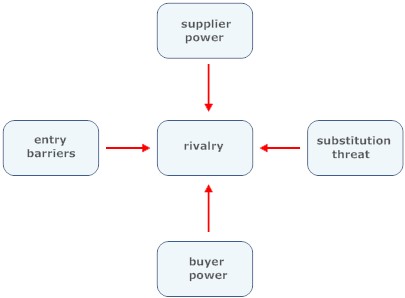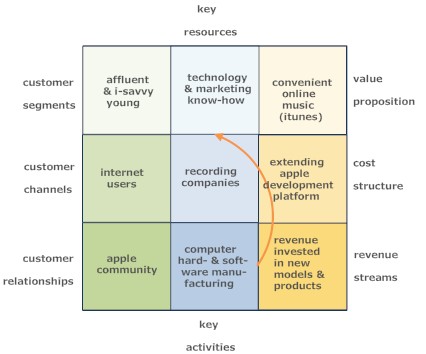 Section
Navigation
Section
Navigation
9. Learning from Others
9.1 Introduction: Grouping by Business Models
:Cautionary Tales
9.2 A Start
9.3 Coins International
9.4 Fine Art Ceramics
9.5 Halberd Engineering
9.6 Ipswich Seeds
9.7 Seascape e-Art
9.8 Whisky Galore
:Case Studies
9.9 Amazon
9.10 Andhra Pradesh
9.11 Apple iPod
9.12 Aurora Health Care
9.13 Cisco
9.14 Commerce Bancorp
9.15 Craigslist
9.16 Dell
9.17 Early Dotcom Failures
9.18 Easy Diagnosis
9.19 eBay
9.20 Eneco
9.21 Fiat
9.22 GlaxoSmithKline
9.23 Google ads
9.24 Google services
9.25 Intel
9.26 Liquidation
9.27 Lotus
9.28 Lulu
9.29 Netflix
9.30 Nespresso
9.31 Netscape
9.32 Nitendo wii
9.33 Open Table
9.34 PayPal
9.35 Procter & Gamble
9.36 SIS Datenverarbeitung
9.37 Skype
9.38 Tesco
9.39 Twitter
9.40 Wal-mart
9.41 Zappos
9.42 Zipcar
 9.11
Apple iPod
9.11
Apple iPod
Apple Inc. was incorporated in 1976 and is headquartered in Cupertino, California.
The company designs, manufactures, and markets smart personal devices,
the Macintosh (Mac) family of personal computers, the iPod portable music
player, the iPhone, and, the iPad, plus various accessories and peripherals
including software, printers, storage devices, speakers, and headphones.
Also important is its online music store iTunes. {18}
Apple reported a total revenue of $108.2 billion in 2011, an increase of 66% over 2010. Sales figures for the iPod iPhone and iPad were 42.6 million, 72.3 million and 32.3 million units respectively. {24}
Business Model: Design and Innovation
Apple is known for well-engineered, attractive products {7} {16} and continual innovation. {10} {11} Its early PCs were 'plug and play', and later machines retained the affection of graphics departments even though the ease of use advantages had largely disappeared. Apple pioneered the PDA market with the Newton in 1993, introduced the easy-to-use iMac in 1998, and the iBook in 1999. Most important still were the 2001 launch of iTunes, the opening of its own own stores, and the introduction of the iPod, which changed the way people listened to music. {1}
In 2002 came flat-panel LCDs for desktops, and in 2003 the release of the iLife package (with contained improved versions of iDVD, iMovie, iPhoto, and iTunes), and its fast Mac G5 PC. Apple continued its advances into digital lifestyle strategy by launching iTunes Music Store online in 2003. Through deals with the large recording companies —BMG, EMI, Sony Entertainment, Universal, and Warner — the iTunes was able to offer over 200,000 songs on its day of opening. {1}
iPod
In the early 2000s, the music industry was facing (and losing) a battle with piracy. Apple's response was firstly, beginning in 2001, to open retail stores across the US to ensure proper marketing of its products. Secondly, in April 2003, Apple launched an Internet-based music selling initiative called iTunes, making deals across the recording industry and preventing piracy with added DRM (digital recording management) software . Thirdly, hard on the heels of iTunes, Appled launched its iPod, which alone could play iTune downloads. Because iPod was an attractive product, and fitted seamlessly with iTunes, the iPod became a smash hit. The revenues of Apple grew from US$ 5.3 billion in 2001 to US$ 13.9 billion in 2005. The corresponding share price of Apple rose 305% from less than US$ 10 to over US$ 40. In 2005, some 23 million iPods were sold, and Apple stock had risen to US$ 75 by December. {3}
The iPod success boosted the brand image of Apple, materially assisting PC sales, which rose from 2.5% in the early 2000s to 4% of the US market by the first half of 2005. In the full year of 2005, Apple sold 4.5 million PCs, one million of them to Windows users who had switched over to Mac. {3}
Subsequently, iPod sales have played a smaller part in Apple's fortunes as Mac and iPhone sales took over. iPods were the primary growth engine for 2006 and 2007, accounting for 58% of Apple's total revenue growth for both years, but in 2007 iPod sales generated only 14% of overall sales growth. As a percentage of total revenue in the financial year, iPod sales were as follows: 33% in 2005, 40% in 2006, 35% in 2007 and 28% in 2008. {6}
Apple slowed the decline in sales in a saturated market by introducing new models as a 'must have' gadget (with new styling, 'touch' operation, Wi-Fi connection and increased memory) {19}, usually at high prices that were slowly scaled back as yet newer models were introduced.
In iPod's first two years on sale, the average selling price (ASP) was around $350. In 4Q 2004, prices were cut by $100, and demand increased considerably. In Q2 2005, Apple priced its 'Min' iPod at $199, and launched the shuffle. The ASP dropped from $264 in Q1 to $191 in Q2, and sales again increased. The ASP gradually fell over the next two years, but volume of units sold remained constant. In 2007, the unit sales growth was 31%, but revenue growth was only 8%.
In 1Q 2008, Apple introduced its Touch model, creating a higher ASP ($181) but an increase too in revenue growth: 10%. In fact, though iPod unit sales only grew 5% year on year for 1Q 2008, dollar sales increased by 17% due to a higher ASP. {6}
Michael Porter's Five Forces Analysis
Porter's Five Forces is a business strategy framework developed by Michael E. Porter of the Harvard Business School in 1979. Since 'pure competition' in an ideal market would drive the profits of all participating companies down to zero, the model identifies five forces that prevent this undesirable result. {20}{21}

Supplier Power
Apple did not fear supplier power because:
1. It had long-established relationships with chip and other parts
suppliers.
2. Considerable competition existed among parts suppliers.
3. iTunes secured partnership agreements with the large recording companies
that met their piracy concerns. {13}
Barriers to Entry
Other companies found it difficult to compete because:
1. Apple was secretive about plans, and the iPod appeared suddenly,
with a considerable headstart over rivals (which Apple maintained with
further products). {16}
2. iPod was new technology, which competitors had to acquire, either
by in -house development (lengthy) or by acquisition (expensive).
3. Apple had secured the necessary patents.
4. Apple possessed a strong brand synonymous with quality.
5. Apple built on user familiarity with Blackberry and other devices,
taking customer expectations to another level. {13}
Buyer Power
Buyers were comparatively weak as:
1. Most purchases were for individual use.
2. iTunes was a service not offered elsewhere.
Threat of Substitutes
Cheaper iPod look-alikes appeared, but Apple headed off the threat of substitutes by:
1. A simple-to-use seamless integration of iTunes with: iPod.
2. Branding iPod as the product setting standards. {16}
3. Marketing the iPod as one of a closed ecosystem of products built
round Apple technology. {12}
Rivalry
Rivalry was initially nonexistent, and Apple retained competitive advantage by:
1. Continually introducing new features and adjusting prices.
2. Controlling its (own) distribution centers.
3. Management vision and consistency with Steve Jobs as CEO from 1997.
{15}
4. Marketing the Apple brand as a 'cool' etc. culture. {12}
In 2007, however, Amazon introduced music downloads with DRM, and Apple had to follow suit.

Points to Note
Apple has enjoyed mixed fortunes, {3} but its revival with the iPod is part of a larger strategy. With the return of Steve Jobs, it: {2}
1. Listened to marketers and correctly sensed a move towards socially-determined
applications, away from PCs that did everything to devices that did
a few things superlatively well.
2. Focused on a few developments, ruthlessly weeding out the rest.
3. Built up the brand name with Apple communities {14}, consistency
{9}, logo {10} and good design. {16}
4. Developed the iPod in conjunction with iTunes: the simple, seamless
operation of the two together made both popular (as Amazon's Kindle
has with wireless-delivered ebooks.)
5. Offered a far greater choice of music than was available from competitor
Microsoft's Zune store. {5}
6. Boosted sales in a declining market by introducing more expensive
models and judiciously reducing prices of earlier models.
7. Used R&D investment more efficiently: as a percent of sales,
Apple's investment is only 4.1% compared to Google's 12% and Microsoft's
15.4%. {13}
 Questions
Questions
1. Explain why the Apple iPod was such a successful product.
2. How did Apple manage the introduction of newer models and products?
3. What is Michael Porter's Five Forces Analysis? Apply it to Apple.
4. Identify the successful strands of Apple's business strategy.
 Sources
and Further Reading
Sources
and Further Reading
1. Case Study on Apple's Business Strategies.
MBA
Knowledge Base. No date: probably 2000.
2. Where Does Apple Go from Here? by Sean Silverthorne. HBS.
February 2004.
3. The Transformation of Apple's Business Model. ICMRIndia.
2006.
4. The Evolution of Apple by Julia Hanna. HBS
July 2007.
5. What were Apple's Comparative Advantages? by Jie Hi, Tony
Jia, Ji Young Lee and Andy Yen. Scribd.
2008.
6. Analyzing Apple's iPod Business by Turley Muller. Seeking
Alpha. November 2008.
7. Apple iPod — Business Model Example Series by Alexander Osterwalder.
Futurelabs.
December 2008.
8. Publishers skeptical of Apple iPad business model by Sam Oliver.
Apple
Insider. February 2010.
9. Apple's secret to success and how to copy it by Alexander
Nick. Passion
Capitalists. June 2010.
10. Apple: A Case Study Analysis by Shane R. Mittan. Western
Michigan University. January 2010.
11. Apple iPad: Business Model Analysis. Telco2.
February 2010.
12. Apple Inc: Case Study by Renjith Streekumar. Slideshare.
October 2010.
13. Apple Business Strategy 2011: Milk the iCow for Growth & Cash
by Christopher Meyer. Working
Wider. November 2010.
14. Apple's Branding Strategy. Marketing
Minds. 2010.
15. Apple's Business Strategy Pt 1: Product Differentiation.
MiniWorkshopSeries.
January 2011.
16. Google versus Apple by Nicolas Bry. Innovation
Excellence. June 2011.
17. Apple's Branding Strategy. Marketing
Minds. 2010.
18. Apple. Wikinvest.
Company profile and figures.
19. iPod. Wikinvest.
Detailed entry with photos of its models and good references.
20. Porter's Five Forces: A Model for Industrial Development.
QuickMBA.
Straightforward but adequate treatment.
21. iPod points to struggle ahead for China by Geoff Dyer. FT.
December 2009.
22. Amazon makes $199 challenge to iPad by Barney Jopson and
David Gelles. FT.
September 2011.
23. The Apple Evolution. WSJ.
2011. Photo slideshow. October 2011.
24. Apple. Yahoo
Finance. April 2012.